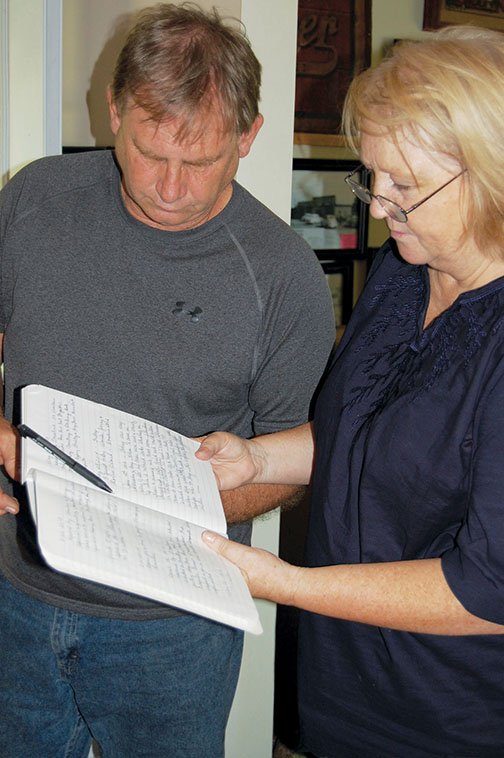Ann Smart, a member of the Haskell Historical Society and a volunteer for the Haskell Historical Museum, said she thought the floor looked damp when she opened the museum for business on June 14.
Stepping in, Smart found that water pipes in what had been the kitchen of the Owen Catton House, which is now the museum, had broken.
She wrote in the museum log about what she found and what she did.
“When I opened the door, I saw that some pieces of tiles were loose and wet. The pipes were broken, the damp had caused some of the ceiling to fall down, and there was mold on the walls,” Smith wrote. “I turned off the water and moved as much of the furniture out as possible. There were no visitors that day, thank goodness.”
Emaline Stroud, president of the society, said the museum, which is usually only open on a few Saturdays a month, had been closed for almost three weeks during the time the original copper waterline broke in the house, which was built in the 1950s.
“I closed the Museum on May 24, and Ann found the water flowing when she opened on June 14,” Stroud said. “It could have broken at any time between those dates.”
Darlene Emmons, another of the founders of the historical society and the museum, showed where the water destroyed the drywall along the outside wall of the old kitchen up to about 3 feet high.
“Everything up to this line is new drywall,” Emmons said, pointing to the line where the new wallboard has been installed. We ruined the tile floor, and the damp inside caused some of the ceiling to drop down.”
The tile and the old floor had been cleared down to the sub-floor. Dixie Smith, another member of the society, pointed out where some of the black mold remained along the baseboards, but most of it had been cleaned away.
The museum, at the corner of Kennedy and Elm streets, will be closed until the repairs are made.
“The city owns the building,” Stroud said. “Mayor [Jeff] Arey came down and looked at the museum and said city workers would make some of the repairs when they had time. There are not a lot of city workers in Haskell.”
Jerry Stroud, Emaline’s husband, said he would make some of the repairs in his spare time. The Strouds and other members of the society transformed the small house into the city’s museum. It opened in 2011. The museum is located in the one square mile of the Haskell city limits.
The good news was that none of the artifacts in the museum was damaged by the water that seemed to stay in the former kitchen area.
“We have a lot of stuff here that could not be replaced,” said Emmons, who was a history and civics teacher at Harmony Grove High School before she retired. She said she first learned about the town’s history from an older teacher whom she worked with early in her career. Emmons said the museum is a good teaching tool for the students in the community.
“Being taught local history, the students get to see that history can be stories of their families living their lives,” Emmons said, “not just the things recorded in history books.”
The city celebrated its centennial on July 1, 2010. Haskell was a railroad town with two tracks coming through the community.
“The Missouri and Pacific Railroad and the Rock Island Line both had depots in the town,” Stroud said in an earlier interview. “Between the tracks, there was a hotel and a church; then another hotel was added soon after the community was made an official town in 1910.”
The commerce of the city was based on the railroads. Freight and passengers were transferred from one line leading south and west, and the other, which went north and east, according to documents in the museum.
Stroud said much of what is known about the history of the community was documented by the book Forty-five Years on the Rock Island Line, by Tom Foster, who was 7 years old when his parents moved to Haskell in 1909.
Historical society members have been collecting items from the city and its residents for years, and ask for items to be brought to meetings of the society. The oldest item is a woolen bedcover.
“Mrs. W.W. White sheared the sheep and spun the wool to make the coverlet,” Stroud said. “She dyed the blue with indigo and made the coverlet. It was made in the 1860s. She was born in 1826 and died in 1877.”
Among the newest items are nylon baseball caps made for each city official in the 1970s. Jerry Stroud, who was a member of the City Council during those years, said he had one of the caps, along with the mayor, the police and fire chiefs, and other city employees.
It will take three or four weeks of work to make all the repairs to the museum, and Jerry said the work will be spread out as the workers find time.
Emaline said the plans are for the museum to be open at least by Nov. 1. A grand opening is planned for that day because it coincides with the Harmony Grove School’s annual reunion.
“There will be a lot of people from out of town coming back to the reunion, and we hope to visit the museum,” she said. “But at the moment, we are a mess.”
Staff writer Wayne Bryan can be reached at (501) 244-4460 or at wbryan@arkansasonline.com.
